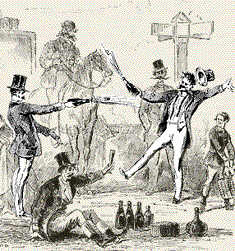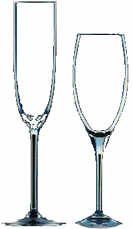Serving champagne with style — removing the cork quietly, cooling the wine to right temperature, and to keep it in the glass and off your guests — is not a natural gift. It requires a little dexterity, concentration, and a good dose of practice.
Champagne should be served in long-stemmed flutes or tulip shaped glasses. These are designed to enhance the flow of bubbles to the crown and to concentrate the aromas of the wine. Never chill or ice the glass as it would take away from the enjoyment of the wine. Incidentally, since the surface texture of crystal is rougher than ordinary glass, more bubbles form on these glasses.
What one drinks champagne out of has often been dictated by fashion. The champagne coupe or saucer-shaped glass, while very popular, was never designed for drinking champagne. It is unstable and does not allow you to fully appreciate the benefits of the wine. There is a legend that it was modelled from the bosom of Marie-Antoinette. Hugh Johnson states that this is not entirely without foundation. "The Sèvres porcelain factory did take a cast from this august model and produced four detailed white bowls that were mounted on elaborate bases of three goat's heads to adorn the Queen's Dairy Temple at the Château de Rambouillet near Versailles. The dairy still exists; as does one of the four coupes."
"I drink champagne when I'm happy and when I'm sad. Sometimes I drink it when I'm alone. When I have company I consider it obligatory. I trifle with it if I'm not hungry and drink it when I am. Otherwise I never touch it – unless I'm thirsty." – Madam Lilly Bollinger
Champagne is to be served cold at about 43 to 48°F (7°C). In this range the smell and taste of the wine can be fully appreciated. This temperature can be achieved by placing the unopened bottle in an ice bucket — one-half ice and one-half water — for 20 to 30 minutes. Or, you may refrigerate it for 3 to 4 hours. The refrigerator temperature is too cold for the bottle to be left in there for extended periods. It should never be placed in the freezer.
Only remove enough of the foil to be able to loosen or remove the twisted-wire hood. It is wise to keep a finger or thumb over the cork at this point as it could pop out of its own accord. If the cork is loose, remove it carefully with the wire hood. Most often though, the cork has to be eased out. To do this, hold the bottle away from you and anyone else, at a 45 degree angle. It is prudent to place the mouth of the bottle nearest the first champagne glass to be filled in case the removal of the cork is mishandled and the wine begins to gush out of the bottle. Hold the cork and gently turn the bottle in one direction. Turn the bottle and not the cork.
The cork should not pop. As the saying goes, "The ear's gain is the palate's loss." You waste bubbles when you pop the cork. When properly executed it should come off with a quiet sigh. The champagne cork is not a toy. There is about 70 pounds-per-square-inch of pressure behind it, thus making it a formidable missile. It helps if the champagne is properly chilled — at 45°F the gas is reduced one atmosphere of pressure — and you avoid shaking it as much as possible before opening it.

Before pouring, the neck should be wiped with a clean linen.Then begin by pouring a little — an inch or so — into everyone's glass allowing the froth to settle. Then go around and top up to about two-thirds. This will prevent any frothing over.
The correct way to pour a bottle of champagne is to hold the base firmly in one hand with the thumb in the punt and the fingers spread out along the barrel of the bottle.
Champagne has reached its maturity and is ready for immediate consumption as soon as it leaves the champagne house. However, champagne may be stored in cellar-like conditions for several years. The important conditions are a constant, cool temperature and no light. The bottles must be stored horizontally to keep the cork moist and thus retain 
Once opened, a bottle of champagne need not be consumed in one sitting. If properly closed – inexpensive champagne stoppers are made just for this purpose – and it is placed in a refrigerator, it should be good for another "bubbling" for up to several days. More of a popular myth than a solution, placing the handle of a silver spoon dangling into the neck of the bottle, will keep the wine sparkling for a few hours. This may be a quaint "solution" if you run out of stoppers.




